The next-gen MacBook Pro with Retina Display Review
by Anand Lal Shimpi on June 23, 2012 4:14 AM EST- Posted in
- Mac
- Apple
- MacBook Pro
- Laptops
- Notebooks
The King of All Notebook Displays
For years Apple has been shipping some of the best displays in consumer notebooks, but the MacBook Pro’s Retina Display is in a league of its own. While I never liked the phrase “painted on” in reference to the iPad and iPhone Retina Displays, that’s the best way I can describe the effect the MacBook Pro’s Retina Display has on me. Text really does look painted on. The effect is really the result of two things.
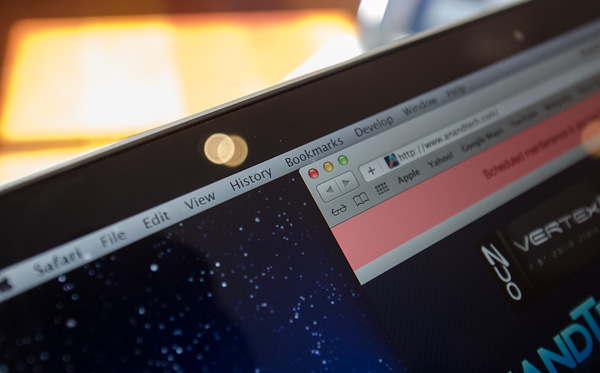
The first is Apple’s removal of its cover glass. LCD panels aren’t particularly attractive, they are ugly squares composed of two pieces of glass and a number of filters/polarizers. To hide the ugly edges, display makers wrap bezels around the display. Most people aren’t fond of bezels so next came a ton of effort to minimize bezel size. An alternative is to simply place a third piece of glass over the entire LCD assembly and make it look as if the bezel and LCD panel are integrated. This outermost layer is known as a cover glass and is what Apple uses on all of its glossy displays. If you’ve ever taken apart a Cinema/Thunderbolt Display or a newer iMac you’ll know that the cover glass is literally just a piece of glass that you have to remove with some suction cups.
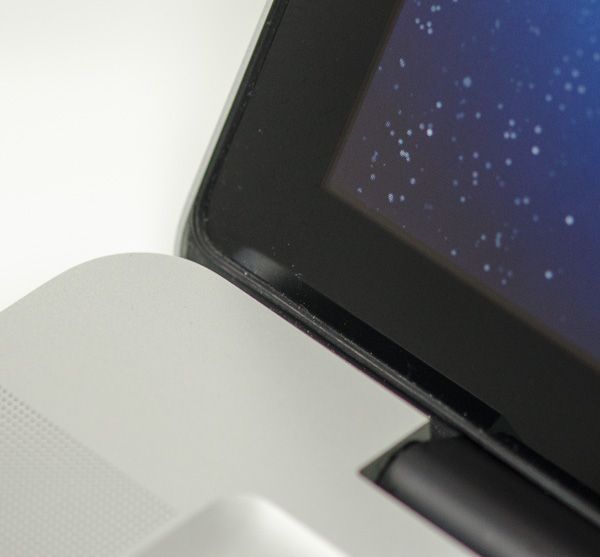
Non-Retina MacBook Pro, notice the gap between the outermost LCD glass and the cover glass
The MacBook Pro’s Retina Display does away with the cover glass and instead uses a fairly unique LCD assembly. There are still two pieces of glass but the outermost glass is actually a different size and shape - it integrates a bezel. By integrating the bezel into the outermost glass in the LCD stack you get the same effect as a cover glass but without the added reflections it introduces.
You also limit the possibility of dust getting trapped between the cover glass and the LCD. The danger is that you no longer have a protective piece of glass in front of your expensive new LCD. If you scratch the display you're scratching the LCD itself. While this has been true for conventional matte displays for a while, it's worth mentioning if you're used to Apple's glossy displays where you did have that added security layer.
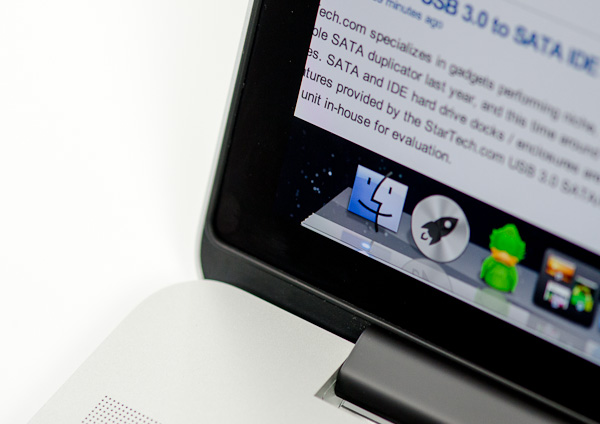
The MacBook Pro with Retina Display, no gap, no cover glass
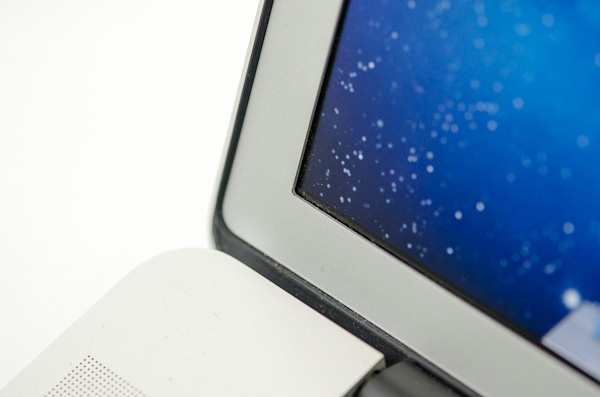
The 2011 MacBook Pro with High-Res Matte display option, no cover glass, top bezel

From left to right: 2010 High Res Glossy MBP, 2012 rMBP, 2011 High Res Matte MBP
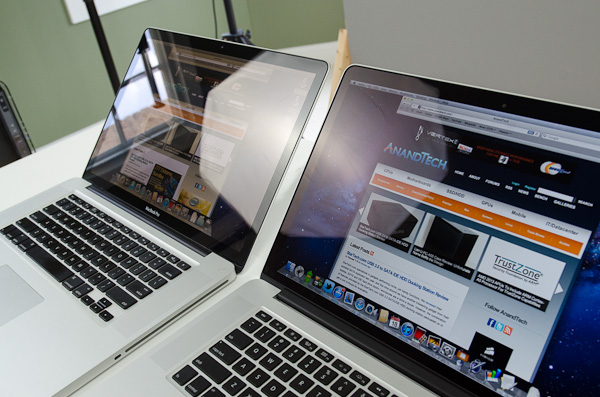
Glare handling indoors - 2011 High Res, Glossy MBP (left) vs 2012 rMBP (right)
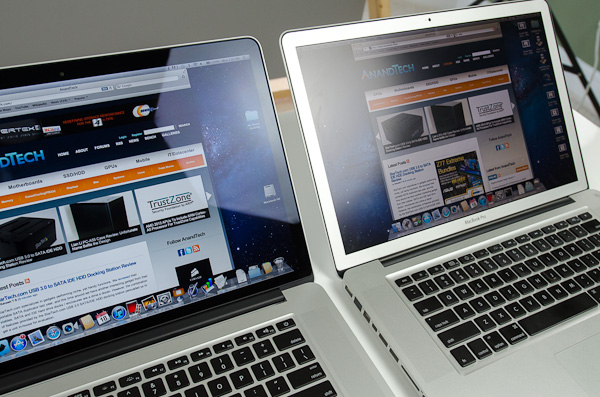
Glare handling indoors - 2012 rMBP (left) vs. 2011 High Res, Matte MBP (right)
The Retina Display is also obviously an extremely high resolution panel at 2880 x 1800. Note that this is 44.6% more pixels than Apple’s 27-inch Thunderbolt Display, and 26.6% more pixels than the 30-inch panels that we’ve loved for so long - all in a 15.4-inch notebook display.
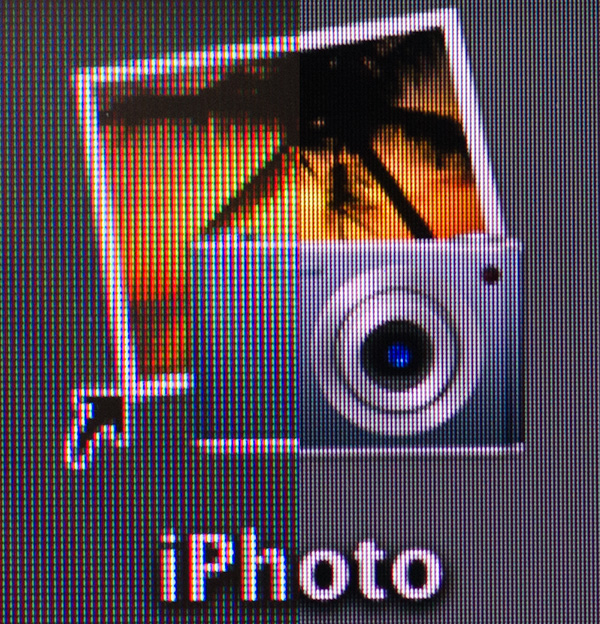
An iPhoto shortcut, High Res 2011 MBP (left) vs. Retina Display MBP (right)
At 220 pixels per inch it’s easily the highest density consumer notebook panel shipping today. At normal viewing distances and even with my face closer than I’m comfortable putting it I simply cannot discern individual pixels.
It’s the combination of these two elements, the removal of the cover glass and the insanely high pixel density that makes everything from text to UI elements just look painted on the new Retina Display. And the effect is gorgeous. I’ve never seen a prettier panel and it’s actually ruined me for pretty much all other displays, notebook and desktop.
While I can appreciate the iPad’s Retina Display, the impact from the MacBook Pro’s display is even more significant. Perhaps it’s because I still spend so much time working on a standard, non-tablet display, but I’m far more excited about this display than anything else Apple has delivered under the Retina moniker.
It’s not just pixel density that Apple has to offer here. Similar to its Retina Displays in the iPhone and iPad, the MacBook Pro’s Retina panel ditches TN in favor of IPS technology. The result is an incredible improvement in viewing angles. On a notebook I don’t spend a lot of time viewing it from far left/right angles, although I see the benefit when I’ve got others huddled around my display. Here the panel performs admirably - you lose brightness at far left/right angles but there’s no perceivable color shift. In fact, the painted on effect is even more impressive at these far left/right viewing angles.
For a single user however the more impressive characteristic is just how good the display looks at vertically off-center angles. I wrote much of the initial parts of this review while on an airplane in coach, which with a 15-inch notebook on my lap means I’m going to be looking at the display at a weird angle to begin with. The thinner rMBP doesn’t do enough to make the airplane usage model any better if the person in front of you decides to recline, but the IPS panel does make the display perfectly usable at the off-center angle you’ll inevitably have to deal with.
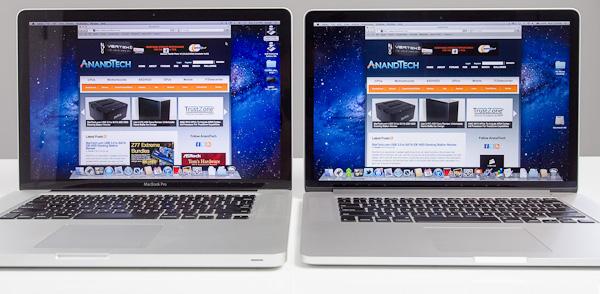
2010 High Res, Glossy MBP (left) vs. 2012 rMBP (right)
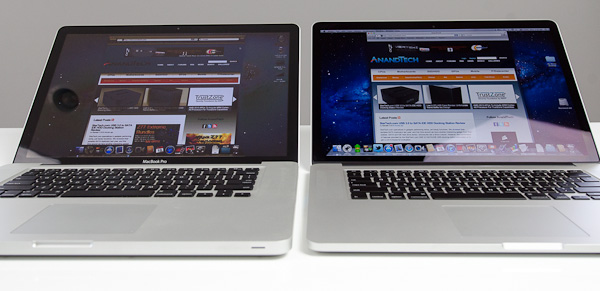
Hello colorshift!
2010 High Res, Glossy MBP (left) vs. 2012 rMBP (right)


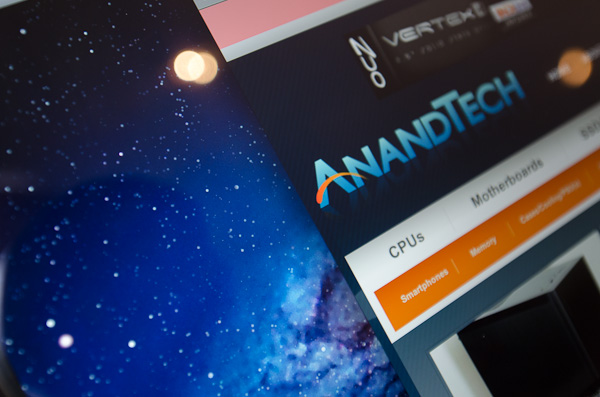
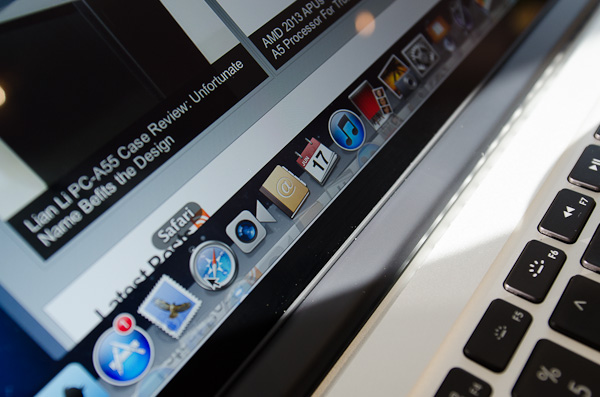
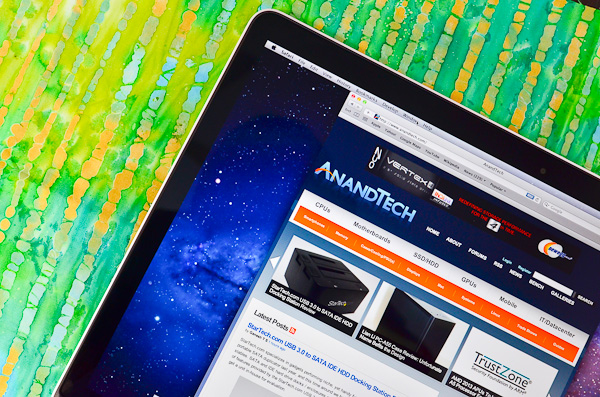
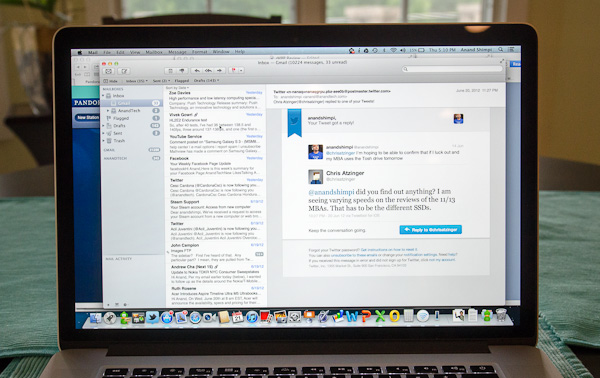
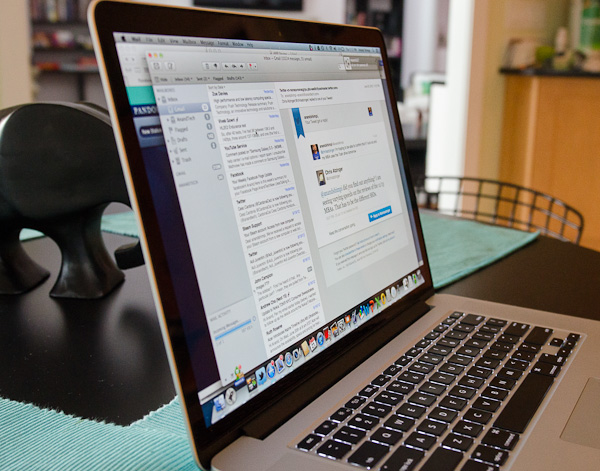








471 Comments
View All Comments
Kill16by9TN - Sunday, June 24, 2012 - link
What I don't understand, how does it make any sense, to use scaling factors resulting in 16:9 (TV/movie) resolutions (2560x1440, 2048x1152, 1600x900) on a 16:10 computer panel with native 2880 x 1800, or scaled down, 1440 x 900 pixels.ImSpartacus - Sunday, June 24, 2012 - link
They aren't. In OSX, you can have 1440x900, 1680x1050 or 1920x1200. Those are all 16:10.Kill16by9TN - Sunday, June 24, 2012 - link
Sorry, looks like my bad. I was so baffled by those 16:9 resolutions in the settings window screen shot, that I completely missed that window's "Thunderbolt Display" title and the monitor icon on the left.So apparently Anand was using a an external 16:9 monitor for this test and everything is fine again ;-).
yottabit - Sunday, June 24, 2012 - link
I just want to take a moment to say thanks for always sticking to the philosophy of not releasing a review until it's ready. Even though other reviews of the Retina display MBP have been up for a while I honestly didn't even read them because I love waiting for what Anand is going to come up with. I still count on Anandtech as my "one-stop-shop" for reviews and I've got to say it does not disappoint.I know people are complaining about the lack of upgrade potential on the retina Mac Book Pro, but I think it's Apple's right. Think about it- they now have a product that is truly unrivaled in any category. Until some other competitors can put pressure on them, I don't think we'll see upgradeability come back into play.
Apple has done something really tremendous here with their retina display panel, I think this is the longest head start they will have ever had on anyone since the iPod. With all the proprietary graphics drivers/GPU scaling, and the development of this custom display at this pricepoint, I really think it will be years before we see a PC with a similar overall package. So long as Apple can maintain exclusivity with it's suppliers (and that's never been a problem in the past)
This display isn't something somebody can just knock off, it's an engineering marvel IMO. And it's going to be hard for any other OEM to justify the volume to market a display like this.
Reading about Apple's influencing Intel to speed up iGFX development sent chills down my spine. I can't believe how much Apple has grown.
I've got to say I think Steve Jobs would be really proud of the launch of this device. I don't think many people realize how big this is going to be!
shushamen - Sunday, June 24, 2012 - link
Anybody knows how the Xcode iOS simulator handle the retina display , I meant what happened when you selected iPad retina, does it scale it or use a pixel to pixel.Currently I am using an imac 27 for iPad dev and even at 2560 x 1440 I have to scroll inside the iOS simulator when target iPad retina ( I know I can use the sim scale option ), I am hoping that with this new MBRD I can solve the issue.
Baked - Sunday, June 24, 2012 - link
How many times do you the cleaning lady come over to dust your mansion? Or do you have live in crew? I'm guessing the latter.Must be nice being so filthy rich.
dtolios - Sunday, June 24, 2012 - link
People talk about "creative laptops" vs. consumer laptops, innovation etc...Apple has been pushing things around for a long time - and failed BIG in the process. And no, not because it was innovative, but because of proprietary stubbornness: be different at all costs. It's not about "creative users"...it's about "wannabees", and that's what 95% or more (guesstimation) of all the MBPs out there are and will be used for. Showing off while browsing FB and tweeting (instead of being creative) in schools and cafes.
The rMBP is a good start for something great, no doubt, and I am happy that all these vanity addicts will fund more and more of the good stuff to grow and mature (cause obviously the screen scaling application has to work a long way to reach enough potential to be used in creative stuff).
Till then, I hope the rMBPs with all the proprietary hardware connections/integration won't make a lot of proud buyers to cry with increased reliability issues and zero user-end customization/repair/replace support ( you know, MBPs have been far from the best in this field already, and it looks it will get lost)...I will be waiting for a year or so to hear what Apple service will ask for a blown MoBo.
robco - Sunday, June 24, 2012 - link
Huh?Apple's sales have outpaced the industry for some time now. Their sales of notebooks has gone up considerably. The MacBook Air is becoming quite popular. If that's failing big, most companies would love to fail that much.
The standard 2.5" form factor wouldn't fit inside an Air or the new rMBP. So Apple had to do their own thing. That's not Apple's fault. The same is true with SO-DIMMs. As for reliability and service, Apple tends to get top marks there too. I have taken my current 2009 MBP in twice. Once to fix a sticky trackpad that wouldn't click, and once to replace the battery. Both times the machine was fixed, under warranty, quickly. I made an appointment, dropped by the Apple Store and they took care of it. Easy.
Apple is not stupid. They've been making the new Air for some time now. If they were constantly replacing blown mobos and components were failing all the time, they wouldn't still be making them. I know quite a few MacBook users and they all have found them to be durable, reliable machines. Most people will likely move to the new Air because they don't need the CPU and GPU power of the new rMBP.
spronkey - Sunday, June 24, 2012 - link
Listen to what you're saying.#1 They designed a machine ignoring existing standards. It's not like they *couldn't* have made a very, very similar machine that used standardised parts. They just chose not to.
#2. SODIMMs? What about pitching a new standard, then? Or how about adding 1mm. Noone would have noticed, and then in two generations they can thin it out even more.
#3. Warranty. Perhaps in the US Apple are good with service. Over here in New Zealand they don't exist - we get Authorised Apple Service Providers, who try their absolute hardest to weasel out of fixing anything, and whose first mandate is to never admit design faults like those that exist with the original MagSafe connectors!
#4. What happens when the machine drops out of warranty? Let's not forget that Apple's 1 year standard warranty isn't exactly generous. Oh wait - Apple want to gouge you some more by offering AppleCare. But it's not just an extended warranty, it comes with all this other crap you don't want, like phone support. And it's four times the price of a retail store's extended warranty.
How about they put their money where their mouth is and start backing up their "superior" devices with superior warranties. Oh, and while they're at it, they can stop price gouging other countries by picking ridiculously low exchange rates to use...
robco - Sunday, June 24, 2012 - link
They do make a similar machine using standardized parts, they still sell the non-retina MBP. It has a standard 2.5" drive bay and SO-DIMMs. It also is larger and heavier. They wanted to slim down the machine and cut down on weight, these were the design trade-offs they had to make.As for warranty, AppleCare costs $50USD more than Dell's three-year warranty upgrade for an XPS 15, expensive but not out of line. For major defects that happen out of warranty, it depends. Apple has made repairs and replacements in the past with battery issues and faulty GPUs.
As for international support, outside major European and Asian countries, it is pretty crappy. It's going to take some effort on Apple's part to improve that. Also bear in mind that we don't have a 15% GST in the US. Our sales taxes vary from state-to-state (some don't have one), so it's not included in the retail price. Here in CA, the price jumps from $2199USD to $2393.92 with $186.92 in sales tax. Not as expensive as the 15% GST in NZ.